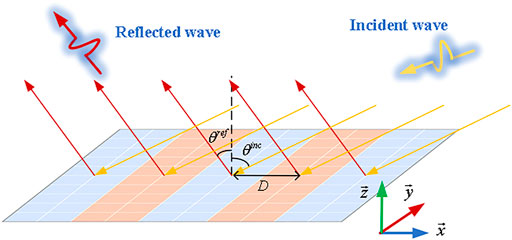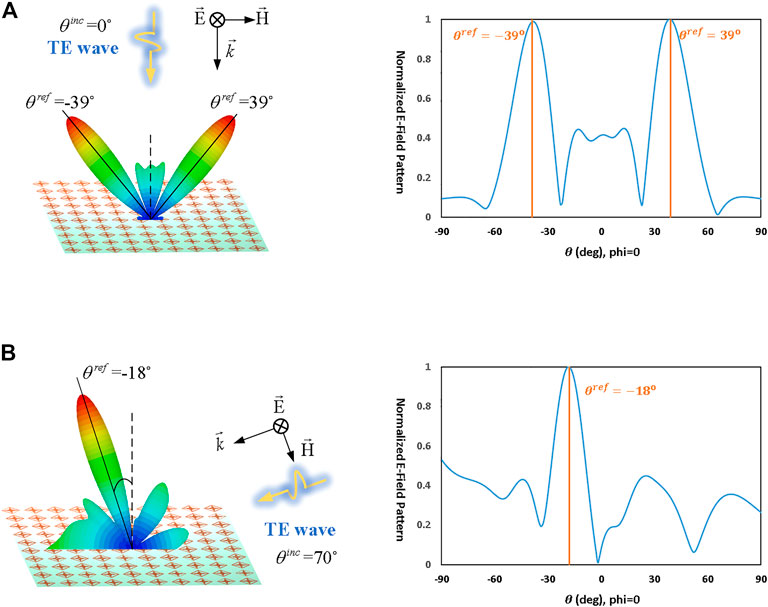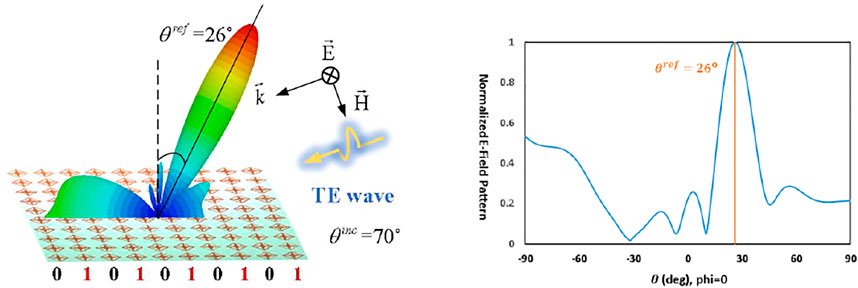
94% of researchers rate our articles as excellent or good
Learn more about the work of our research integrity team to safeguard the quality of each article we publish.
Find out more
ORIGINAL RESEARCH article
Front. Mater., 06 July 2022
Sec. Metamaterials
Volume 9 - 2022 | https://doi.org/10.3389/fmats.2022.933163
This article is part of the Research TopicDigital Programmable Metasurface: Design, Fabrication and ApplicationsView all 7 articles
Programmable metasurfaces have the powerful capability of controlling electromagnetic (EM) waves by coding the digital state of each meta-atom. However, conventional programmable metasurface units are difficult to maintain stable controllability under wide-angle incidence conditions, which limits the application of 1-bit programmable metasurfaces in single-beam scanning. A 1-bit dual-polarized programmable metasurface that allows oblique incidence at large angles is presented in this article. Inspired by the principle of reciprocity in the antenna theory, a wide-angle patch antenna which operates in the receiving mode and is loaded by a PIN-diode–based load circuit is designed as the basic structure of the meta-atom. Numerical simulations show that the 1-bit coding state maintains good angular stability within ±70 degrees of the incident angle for both orthogonally polarized EM waves, and single-beam scanning can be achieved at large oblique incident angles for any polarization.
Metasurfaces have received extensive attention from researchers due to their powerful electromagnetic (EM) wavefront control capabilities (Cui et al., 2016; Li et al., 2017; He and Eleftheriades, 2019). Different from the basic modulate strategies of traditional metasurfaces, programmable metasurfaces construct a digital space on the physical space of metamaterials, which allows the real-time and dynamic modulation of EM waves by controlling digital codes, providing new architecture for wireless communication (Liu et al., 2016; Wan et al., 2016; Cui et al., 2019). Therefore, programmable metamaterials have developed rapidly since the concept was proposed by Cui et al. (2014).
Generally, traditional phased array antennas can achieve beam steering by changing the excitation amplitude and phase of the array elements; however, this usually relies on a complex and expensive phase-shifting network (Liu et al., 2019). Compared with traditional phased arrays, the new antenna system based on programmable metasurfaces can miniaturize the complex phase-shifting modules, reduce the manufacturing cost, and, in addition, have the advantage of flexible control (Wan et al., 2016; Zhang et al., 2020).
For an N*N programmable metasurface with n-bit, the degree of freedom for this metasurface to control the EM waves is a function of the element number N and bit number n. The larger the value of n is, the higher the degree of freedom of EM wave controllability is. Programmable metasurfaces are usually periodically integrated by active devices (such as the PIN-diode, varactor, and MEMS chips) and subwavelength meta-atoms, and a field-programmable gate array (FPGA) can be used to generate the coding sequence to control the electrical characteristics of each active devices so as to achieve in-time and precise control of the amplitude and phase of the EM wavefront (Liu and Cui, 2017; Zhang et al., 2020). Metasurfaces with a high bit number usually have higher requirements on the cell structure design. In comparison, 1-bit metasurfaces are easier to design.
However, due to the phase symmetry and structural symmetry, 1-bit metasurfaces will generate multiple symmetrical beams under the normal incidence excitation, which is undesirable for scanning arrays and difficult to eliminate by changing the coding mode. To achieve single-beam scanning, a large angle of oblique incidence is required. However, conventional metasurface units are difficult to maintain stable coding characteristics under wide-angle incidence conditions. The wide-angle stability of programmable metasurface has been studied by Zhang and Cui (2019) and Liang et al. (2021). The meta-atoms proposed in these literature reports can maintain stable coding performance in the range of
Based on the principle of reciprocity and inspired by the design method of antennas, a meta-atom with wide-angle characteristics and polarization-free properties is designed in this article, providing a low-cost approach for single-beam scanning. A wide-angle and dual-polarized patch antenna operating in the receiving mode and loaded by a PIN-diode-based load circuit is designed as the basic structure of the meta-atom. The phase interval required for 1-bit coding can be achieved by switching the on–off state of the PIN-diode and remains stable over a wide-angle incidence range for any polarization.
The principle of antenna reciprocity indicates that the basic characteristic parameters of the antenna when it is used as a receiver are the same as those when it is used for transmission, which means that a transmit antenna with wide-beam can also have wide-angle characteristics when it is used for receiving. Furthermore, the scattering field of the receiving antenna is composed of modal scattering and structural scattering based on the antenna scattering theory, where the modal term is related to the load condition (Andersen and Frandsen, 2005; Best and Kaanta, 2009). Therefore, when the receiving antenna is used as a meta-atom, the required reflection coefficient phase interval can be realized by appropriately controlling the load condition of the antenna.
In order to realize the wide-angle and polarization-free properties of the meta-atom, a microstrip patch antenna with wide-beam, high-isolation, and dual-polarization characteristics, as proposed by Huang et al. (2019), has been chosen as the basic structure of the meta-atom, as shown in Figure 1. The radiating patch of this antenna is a four-pointed star fed by two orthogonal striplines. The element size

FIGURE 1. Schematic representation of the proposed meta-atom. (A) Explosive view; (B) sketch of the patch and feed line; (C) load circuit composed of the PIN-diode and transmission line in series.
The two feeding ports of the antenna are, respectively, connected to a load circuit formed by a certain length of microstrip line and a PIN-diode (MA4AGP907 from MACOM) connected in series at the bottom of substrate 3, as shown in Figure 1C. The lengths of the microstrip line are
The full-wave numerical simulation software CST Microwave studio was used to analyze the electromagnetic properties of the proposed meta-atom under different coding states and incident angles. The code “0” represents the “on” state of the PIN-diode; on the contrary, the code “1” represents the “off” state of the PIN-diode. Figure 2A shows the reflection coefficient phase characteristics of the meta-atom under the TE wave illumination at the incident angles of

FIGURE 2. Simulated reflection coefficient characteristics of the meta-atom under the TE wave illumination at different incident angles. (A) Phase properties; (B) amplitude properties.
Figure 2B is the corresponding amplitude characteristics. The amplitude of the reflection coefficient is close to 1 when the PIN-diode is turned off at the working frequency, which means the energy is almost totally reflected. When the PIN-diode is turned on, the reflection amplitude decreases due to the loss and mutual-coupling caused by the circuit, but it is all greater than 0.7. Based on the antenna array theory, the beam properties of a large array depend more on the phase characteristics than the amplitude of each unit. Therefore, the beam steering capability of the metasurface formed by this unit can still be guaranteed.
The phase and amplitude characteristics of the PIN-diode in two states under TM wave illumination from

FIGURE 3. Simulated reflection coefficient characteristics of the meta-atom under the TM wave illumination at different incident angles. (A) Phase properties; (B) amplitude properties.
To sum up, the proposed meta-atom exhibits stable angular insensitivity in the reflection amplitude and phase responses over a wide range of incident angles for both TE and TM polarization around 3 GHz due to the good wide-beam and dual-polarization properties of its radiation mode. The performance comparison of the proposed programmable metasurface with recently reported relevant works is presented in Table 1. It can be seen that the proposed metasurface not only provides a wider incident range but also removes the restriction on the polarization mode of the incident wave. It should be pointed out that the problem that this article attempts to solve is the limitation that the 1-bit metasurface is difficult to achieve single-beam scanning under normal incidence excitation, and thus, high bit number is not our goal.
To verify the modulation capability of the programmable metasurface constructed by the proposed meta-atom. A 10*10 array, as shown in Figure 4, has been simulated. The coding sequence in the x direction is 0011001100.
The reflected beam pointing angle of the programmable metasurface with different coding sequences and different incident angles can be estimated by the geometrical-optical approximation method, as shown in Figure 5. The main lobe usually points in the direction where the electric fields are superimposed in phase. Assuming that the amplitude of the reflection coefficient for each unit is uniform and the phase difference between the two coding states is 180° and taking the keyboard coding mode as an example, the in-phase superposition should satisfy the following formula:
which is related to the phase delay caused by the path difference of oblique incidence, the phase difference of metasurface modulation, and the phase delay caused by the reflection. Here,

FIGURE 5. Schematic diagram of the relationship between the incident wave and reflected wave based on the geometrical-optical approximation method.
The electric field pattern under the normal incident condition of the TE polarization wave is shown in Figure 6A. Two symmetrical beams pointing at

FIGURE 6. Electrical field patterns of the proposed programmable metasurface under different incident angles. (A) Normal incidence; (B) oblique incidence of
It can be seen that the 1-bit metasurface will inevitably generate two symmetrical beams in the upper half–space under normal illumination, which means that the 1-bit metasurface cannot achieve single-beam scanning under normal incident conditions or small incidence angles. When the energy needs to be concentrated into a single beam of radiation, a large angle of oblique incidence is required. Figure 6B shows the electric field pattern at an oblique incidence of
To verify its polarization-free characteristics, a TEM plane wave consisting of both TE and TM polarization is used as the incident condition. The angle between the electric field polarization direction of the TEM plane wave and the incident plane is

FIGURE 7. Electrical field pattern of the proposed programmable metasurface under TEM wave illumination at an oblique angle of
According to formula (1), the beam direction is related to D, determined by the coding scheme and incident angle

FIGURE 8. Electrical field pattern of the proposed programmable metasurface with “0101 … ” coding sequence at
In this article, a wide-angle and polarization-free programmable metasurface has been proposed. For arbitrarily polarized TEM waves, it maintains a stable
The original contributions presented in the study are included in the article/supplementary material; further inquiries can be directed to the corresponding author.
HCZ put forward the initial idea and supervised the project. LL performed the model design and drafted the manuscript. YFH helped with the simulation analysis. All authors fully contributed to the research.
This work is supported by the Natural Science Foundation of Fujian Province, China (Grant No. 2021J05179); the National Natural Science Foundation of China (Grant No. 62101122); the Natural Science Foundation of Jiangsu Province of China (Grant No. BK20210212); and the Fundamental Research Funds for the Central Universities (Grant No.2242021R10107).
The authors declare that the research was conducted in the absence of any commercial or financial relationships that could be construed as a potential conflict of interest.
All claims expressed in this article are solely those of the authors and do not necessarily represent those of their affiliated organizations, or those of the publisher, the editors, and the reviewers. Any product that may be evaluated in this article, or claim that may be made by its manufacturer, is not guaranteed or endorsed by the publisher.
Andersen, J. B., and Frandsen, A. (2005). Absorption Efficiency of Receiving Antennas. IEEE Trans. Antennas Propagat. 53 (9), 2843–2849. doi:10.1109/TAP.2005.854532
Best, S. R., and Kaanta, B. C. (2009). A Tutorial on the Receiving and Scattering Properties of Antennas. IEEE Antennas Propag. Mag. 51 (5), 26–37. doi:10.1109/MAP.2009.5432036
Cui, T.-J., Liu, S., and Li, L.-L. (2016). Information Entropy of Coding Metasurface. Light Sci. Appl. 5 (11), e16172. doi:10.1038/lsa.2016.172
Cui, T. J., Liu, S., Bai, G. D., and Ma, Q. (2019). Direct Transmission of Digital Message via Programmable Coding Metasurface. Research 2019, 1–12. doi:10.34133/2019/2584509
Cui, T. J., Qi, M. Q., Wan, X., Zhao, J., and Cheng, Q. (2014). Coding Metamaterials, Digital Metamaterials and Programmable Metamaterials. Light Sci. Appl. 3 (10), e218. doi:10.1038/lsa.2014.99
He, Y., and Eleftheriades, G. V. (2020). A Thin Double-Mesh Metamaterial Radome for Wide-Angle and Broadband Applications at Millimeter-Wave Frequencies. IEEE Trans. Antennas Propagat. 68 (3), 2176–2185. doi:10.1109/TAP.2019.2951491
Huang, H., Li, X., and Liu, Y. (2020). A Low-Profile, Single-Ended and Dual-Polarized Patch Antenna for 5G Application. IEEE Trans. Antennas Propagat. 68 (5), 4048–4053. doi:10.1109/TAP.2019.2948743
Li, L., Jun Cui, T., Ji, W., Liu, S., Ding, J., Wan, X., et al. (2017). Electromagnetic Reprogrammable Coding-Metasurface Holograms. Nat. Commun. 8 (1), 1–7. doi:10.1038/s41467-017-00164-9
Liang, J. C., Cheng, Q., Gao, Y., Xiao, C., Gao, S., Zhang, L., et al. (2021). “An Angle-Insensitive 3-Bit Reconfigurable Intelligent Surface,” in IEEE Transactions on Antennas and Propagation (IEEE), 1. doi:10.1109/TAP.2021.3130108
Liu, F., Liu, Y., Xu, K. D., Ban, Y.-L., Liu, Q. H., and Guo, Y. J. (2019). Synthesizing Uniform Amplitude Sparse Dipole Arrays with Shaped Patterns by Joint Optimization of Element Positions, Rotations and Phases. IEEE Trans. Antennas Propagat. 67 (9), 6017–6028. doi:10.1109/TAP.2019.2920238
Liu, S., and Cui, T. J. (2017). Flexible Controls of Terahertz Waves Using Coding and Programmable Metasurfaces. IEEE J. Sel. Top. Quantum Electron. 23 (4), 1–12. doi:10.1109/JSTQE.2016.2599273
Liu, S., Cui, T. J., Zhang, L., Xu, Q., Wang, Q., Wan, X., et al. (2016). Convolution Operations on Coding Metasurface to Reach Flexible and Continuous Controls of Terahertz Beams. Adv. Sci. 3 (10), 1600156. doi:10.1002/advs.201670053
Wan, X., Qi, M. Q., Chen, T. Y., and Cui, T. J. (2016). Field-programmable Beam Reconfiguring Based on Digitally-Controlled Coding Metasurface. Sci. Rep. 6 (1), 1–8. doi:10.1038/srep20663
Zhang, L., and Cui, T. J. (2019). “Angle-Insensitive 2-Bit Programmable Coding Metasurface with Wide Incident Angles,” in 2019 IEEE Asia-Pacific Microwave Conference (APMC) (Singapore: IEEE), 932–934.
Zhang, L., Wang, Z. X., Shao, R. W., Shen, J. L., Chen, X. Q., Wan, X., et al. (2020). Dynamically Realizing Arbitrary Multi-Bit Programmable Phases Using a 2-bit Time-Domain Coding Metasurface. IEEE Trans. Antennas Propagat. 68 (4), 2984–2992. doi:10.1109/TAP.2019.2955219
Keywords: wide-angle, polarization-free, programmable metasurface, receiving antenna, 1-bit
Citation: Liu L, Huang YF and Zhang HC (2022) Design of a Wide-Angle and Polarization-Free 1-Bit Programmable Metasurface. Front. Mater. 9:933163. doi: 10.3389/fmats.2022.933163
Received: 30 April 2022; Accepted: 26 May 2022;
Published: 06 July 2022.
Edited by:
Wenlong Gao, University of Paderborn, GermanyCopyright © 2022 Liu, Huang and Zhang. This is an open-access article distributed under the terms of the Creative Commons Attribution License (CC BY). The use, distribution or reproduction in other forums is permitted, provided the original author(s) and the copyright owner(s) are credited and that the original publication in this journal is cited, in accordance with accepted academic practice. No use, distribution or reproduction is permitted which does not comply with these terms.
*Correspondence: Hao Chi Zhang, MTAxMDEyOTEwQHNldS5lZHUuY24=
Disclaimer: All claims expressed in this article are solely those of the authors and do not necessarily represent those of their affiliated organizations, or those of the publisher, the editors and the reviewers. Any product that may be evaluated in this article or claim that may be made by its manufacturer is not guaranteed or endorsed by the publisher.
Research integrity at Frontiers

Learn more about the work of our research integrity team to safeguard the quality of each article we publish.